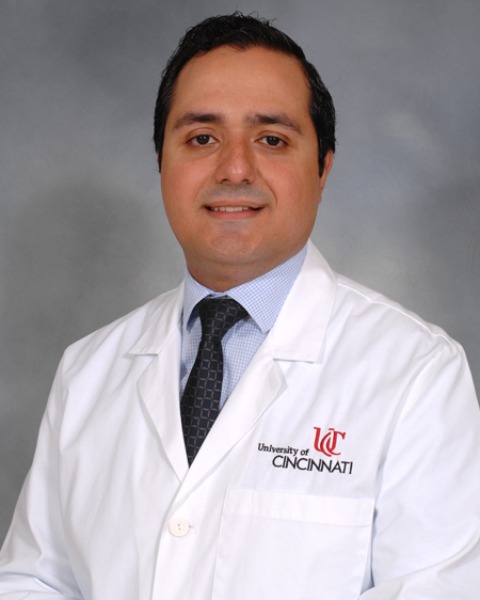Thyroid
(6.04) Impending Thyroid Storm in Patient with Molar Pregnancy

Ehab A Embaby Abdelgyed, MBBCh (he/him/his)
Endocrine fellow
University of Cincinnati
Cincinnati, Ohio, United States
Submitter(s)
Thyroid storm is a rare, life-threatening condition characterized by severe clinical manifestations of thyrotoxicosis. the incidence of thyroid storm is 0.57 to 0.76 per 100,000 persons per year in the United States.
Gestational trophoblastic diseases (GTDs) include hydatidiform moles and choriocarcinoma. GTDs occur in approximately 121 per 100,000 pregnancies in the United States.
Case(s) Description : A 40-year-old female patient with a history of recently diagnosed molar pregnancy presented to the emergency department with fever, nausea, abdominal pain, and vaginal bleeding. Her vitals showed a fever of 102.5 F and tachycardia of 119 beats/min. Her lab work showed significantly elevated Beta-HCG 1,128,500, undetectable TSH, elevated free T4 2.38, total T3 223.4, and negative Ab screening for Graves.
Her Burch and Wartofsky score was 30 based on her Fever, tachycardia, abdominal pain, and nausea indicating an impending thyroid storm. She was treated empirically with beta-blocker, stress steroids, and propylthiouracil, especially in the setting of planned emergent D&C.
After surgery, She was admitted to the ICU for close monitoring. when she became clinically stable, she was switched to methimazole. Her free T4 trended down. The patient was discharged home on methimazole in stable condition to follow up outpatient.
Discussion : In normal pregnancy, elevated levels of hCG can transiently increase T4 secretion and suppress TSH because there is structural homology of the β-subunit of hCG and TSH.
Hyperthyroidism is known to be associated with GTDs because of significantly higher and sustained β-hCG levels compared to normal pregnancy.
The diagnosis of thyroid storm is based on clinical presentation and biochemical evidence of hyperthyroidism. Altered mentation can be the only clinical finding distinguishing a thyroid storm from compensated hyperthyroidism. The mortality rate of thyroid storm is high. Death may be from cardiac failure, cardiovascular collapse, hyperthermia, or multiple organ failure.
Burch and Wartofsky's score helps early identification of thyroid storm. It is sensitive, but it is not very specific
Most patients with thyroid storm have Graves' disease, and some have toxic adenoma or toxic multinodular goiter. Thyroid storm is often precipitated by an acute event such as thyroid or nonthyroidal surgery, trauma, infection, acute iodine load e.g., amiodarone use, contrast, Parturition, irregular use, or discontinuation of antithyroid drugs.
Prevention of thyroid storm is the key and involves recognizing and actively avoiding common precipitants e.g., ensuring that patients are euthyroid prior to elective surgery, labor, and delivery. Educate patients about the effects of excess iodine exposure e.g., CT with contrast. ensure patient compliance with medication. Prenatal care and early detection of molar pregnancy helped decrease the incidence of thyroid storm.
